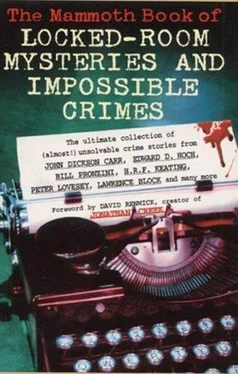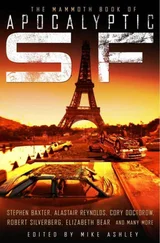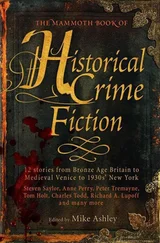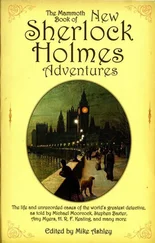Mike Ashley - The Mammoth Book of Locked-Room Mysteries And Impossible Crimes
Здесь есть возможность читать онлайн «Mike Ashley - The Mammoth Book of Locked-Room Mysteries And Impossible Crimes» весь текст электронной книги совершенно бесплатно (целиком полную версию без сокращений). В некоторых случаях можно слушать аудио, скачать через торрент в формате fb2 и присутствует краткое содержание. Жанр: Детектив, на английском языке. Описание произведения, (предисловие) а так же отзывы посетителей доступны на портале библиотеки ЛибКат.
- Название:The Mammoth Book of Locked-Room Mysteries And Impossible Crimes
- Автор:
- Жанр:
- Год:неизвестен
- ISBN:нет данных
- Рейтинг книги:3 / 5. Голосов: 1
-
Избранное:Добавить в избранное
- Отзывы:
-
Ваша оценка:
- 60
- 1
- 2
- 3
- 4
- 5
The Mammoth Book of Locked-Room Mysteries And Impossible Crimes: краткое содержание, описание и аннотация
Предлагаем к чтению аннотацию, описание, краткое содержание или предисловие (зависит от того, что написал сам автор книги «The Mammoth Book of Locked-Room Mysteries And Impossible Crimes»). Если вы не нашли необходимую информацию о книге — напишите в комментариях, мы постараемся отыскать её.
A new anthology of twenty-nine short stories features an array of baffling locked-room mysteries by Michael Collins, Bill Pronzini, Susanna Gregory, H. R. F. Keating, Peter Lovesey, Kate Ellis, and Lawrence Block, among others.
The Mammoth Book of Locked-Room Mysteries And Impossible Crimes — читать онлайн бесплатно полную книгу (весь текст) целиком
Ниже представлен текст книги, разбитый по страницам. Система сохранения места последней прочитанной страницы, позволяет с удобством читать онлайн бесплатно книгу «The Mammoth Book of Locked-Room Mysteries And Impossible Crimes», без необходимости каждый раз заново искать на чём Вы остановились. Поставьте закладку, и сможете в любой момент перейти на страницу, на которой закончили чтение.
Интервал:
Закладка:
I picked up the bottle to see what he was drinking this month. It was a California pear brandy. I’d never had pear brandy. I tried it. It was good. I poured some more and organized the story in my mind. “Some of this is guesswork,” I told him, “but I think most of it will hold.”
“Let’s hear it,” Junior said.
“The apartment Feodore was killed in was their trysting-place,” I said. “It may have been picked for its location, or the location might have suggested the scheme, I don’t know.”
“Just what was the scheme?”
“I’m getting there. Paula and Feodore decided to leave and take the painting with them. Since they would be the obvious suspects, they had to make it look as though it would have been impossible for them to have done it. I would guess that Feodore was supposed to make himself visible in San Francisco when the painting went missing. A couple of days before the theft they ran a string – probably a high-strength monofilament fishing line – between the Czeppskis’ front window and the front window in the other apartment. They looped it around the metal rod of a standing lamp, that was pushed up against the louvered window on the left side of the picture window, and took it back across the street. It was probably tied off to a hook outside the Czeppskis’ window to make sure it wasn’t seen by the Czeppskis. From the street eight floors below it would be completely invisible.”
“So they pulled the painting across the street on a string?”
“No. Remember, Feodore wasn’t supposed to be there. On the day of the theft Paula waited until ma and pa Czeppski left, and then tied a rope – I’d guess a one-inch braided nylon line from a naval supply store – to one end of the monofilament and pulled it through. It looped around the lamp rod and returned, and she tied both ends off. Then, using the curtain rod from the Czeppskis’ apartment for balance, she walked across the rope with the picture strapped to her back. Remember, the Czeppskis had a circus act. What do you want to bet that Paula was a high-wire performer in that circus?”
“Son of a bitch!” Junior remarked.
“She went in through the picture window. The glass pane, I assume, had been previously loosened in its frame. There were two little circles on the glass where she used one of those suction clamps to hold the pane. The old wallpaper on the living room wall had been peeled back, and a hole cut in the plaster and lathe to hold the St Simon. Then she pasted the wallpaper back down. Which, presumably, is when Feodore walked in.”
“If he was there to steal the painting and run off by himself, why didn’t he wait?” Junior asked.
“He did wait,” I told him. “The painting was supposed to have been delivered the day before, but it was held up in customs. So the robbery was scheduled for the day before. He didn’t know it had been changed.”
“So she shot him and went back out the window.”
“Right. Then she put the glass pane back and smeared some putty around the outside to hold it in place – I found a dab of putty on the window sill. She may have even stuck some framing around it or even a nail or two. It must have taken two or three minutes – and all the time a crowd was banging at the front door.”
“The lady has good nerves,” Junior commented.
“I’d say so. She walked across an eighty-foot length of rope both ways pretty much in the dark. Then when she got back to her apartment she had to put the curtain pole back and rehang the curtains. And in the dark – she couldn’t turn the lights on in case someone saw her standing in the window and wondered what she was doing – she missed one of the rungs on the curtain. Then she coiled up the rope and dropped it out the window.”
“That’s quite a story,” Junior said. “Any more to it?”
I shrugged. “I guess that’s pretty much it. Then she stripped down to something brief and clinging so the building staff could see she that she wasn’t leaving with the St Simon, and went out for a night on the town. If I hadn’t picked up on a few little pointers – the curtain rung, the coil of rope on the roof of the garage, the plaster dust – she might have gotten away with it.”
Junior mused for a minute. “She probably left fingerprints all over that room,” he said. After all, she wasn’t planning to kill anybody. But her prints probably aren’t on file anywhere here in the ‘states, and there wasn’t anything to connect the two apartments except proximity. You’re right, if Gibson hadn’t asked you to look things over, she might have walked away from it. What made you suspect her in the first place?”
“She got a little too talkative and nasty when I was looking out the window. I thought she was trying to distract me by getting me mad, and I wondered just what she was distracting me away from.”
Junior drank up his pear brandy and went over to pick up the St Simon. “I’ll put this in the safe,” he said. “You go home and get some sleep. If Fid Must doesn’t find some way to renege on the bonus, I’ll see that you get most of it.”
“More than I expected,” I told him, “but welcome just the same.”
THE PROBLEM OF THE CROWDED CEMETERY by Edward D. Hoch
Edward D. Hoch (b.1930) is a literary phenomenon. He has written over 800 short stories since his debut with “Village of the Dead” in Famous Detective Stories for December 1955. This, in an age when the all-fiction magazine has all but curled up and died. He has had a story (sometimes more) in every issue of the prestigious Ellery Queen’s Mystery Magazine ( or EQMM for ease ) since May 1973, a record which surely can never be equalled by anyone in any magazine. What is even more amazing about Ed Hoch is his versatility. Despite this awesome level of production his stories still manage to be original and enjoyable. He is able to ring the changes on every idea in the book. Quite a number of his stories have been impossible crimes – more than any other writer’s. I mention many of these in my afterword. His best known series of impossible crimes are those narrated by New England doctor Sam Hawthorne, who looks back over his long life and tells the stories of the many strange crimes with which he was involved. The series began with “The Problem of the Covered Bridge ” EQMM, December 1974) which is set in March 1922. The early stories have been collected as Diagnosis: Impossible (1996). I’ve selected a later story that has not been reprinted since its first outing, and which deals with the most remarkable mystery of how a freshly dead body ends up in a long-buried coffin!
I used to picnic in Spring Glen Cemetery in my younger days (Dr Sam Hawthorne told his visitor over a suitable libation). That was when the place was more like a park than a cemetery, bisected by a creek that flowed gently through it most of the year. It was only in the spring, with the snow melting on Cobble Mountain, that the creek sometimes overflowed and flooded part of the graveyard.
That was what happened following the especially harsh winter of ’36. The flooded creek had so eroded the soil on its banks that several acres of cemetery land had been lost. I was a member of the cemetery’s board of trustees at that time and when we met in the spring of 1939 it was obvious something had to be done.
“It’s just been getting worse for the past three years,” Dalton Swan was saying as he showed us photographs of the damage done by the flooded stream. He was the tall, balding president of the board, a rotating responsibility each of the five members had assumed at one time or another. Swan, a fiftyish bank president, was in the second year of his two-year term.
Читать дальшеИнтервал:
Закладка:
Похожие книги на «The Mammoth Book of Locked-Room Mysteries And Impossible Crimes»
Представляем Вашему вниманию похожие книги на «The Mammoth Book of Locked-Room Mysteries And Impossible Crimes» списком для выбора. Мы отобрали схожую по названию и смыслу литературу в надежде предоставить читателям больше вариантов отыскать новые, интересные, ещё непрочитанные произведения.
Обсуждение, отзывы о книге «The Mammoth Book of Locked-Room Mysteries And Impossible Crimes» и просто собственные мнения читателей. Оставьте ваши комментарии, напишите, что Вы думаете о произведении, его смысле или главных героях. Укажите что конкретно понравилось, а что нет, и почему Вы так считаете.










